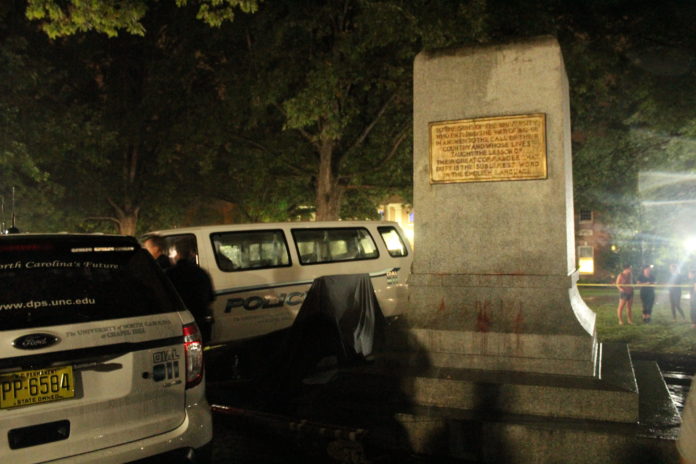After months of protests, the University of North Carolina at Chapel Hill (UNC) administration has continued in its tone-deaf responses to student and faculty outcry. Protesters tore down Silent Sam, a statue that had stood in the center of UNC’s campus since 1913 and was originally erected to commemorate “the sons of the University who died for their beloved Southland,” according to the UNC Graduate School website, on August 20. Debate over the statue has continued since then, with demonstrators on both sides staging protests and Chapel Hill police arresting several protesters.
Through a speech from UNC Chancellor Carol Folt, the school’s Board of Trustees revealed its plan for the statue December 3. The Board proposed building a $5 million structure on the edge of campus, meant to house the statue in a more secure area and educate the public about the statue’s history, which led to a night of campus protests and one arrest, just hours after the news broke.
The administration has chosen to reinstall the statue despite its forcible removal by protesters, citing a 2015 state law that prohibits government agencies from permanently removing or relocating state-owned statues. Instead of fighting against the legislation or taking a firm stance with the law and reinstalling the statue on its pedestal, the administration has made a clumsy attempt to reach a middle ground, proposing to spend millions of dollars that could be used in several other areas to erect an expensive building dedicated to a statue commemorating soldiers who fought to maintain slavery in North Carolina.
A university administration’s actions should reflect the values of its student body, but apparently the national noise created in August at the statue’s removal was not loud enough to make the message of the protesters clear. The North Carolina Board of Governors will have to approve the proposal at a December 14 meeting for the plan to be official, but the fact that the administration would even attempt to move backwards in such a blatant way is disappointing to say the least.
Silent Sam, named for his lack of ammunition and thus inability to shoot his gun, was erected in 1913. The man who gave the speech at the statue’s dedication, Julian Carr, was an industrialist, a Confederate soldier and a known white supremacist. During his speech, he commended the Confederacy for saving “the very life of the Anglo-Saxon race in the South.” He also bragged about whipping an African-American woman for insulting a white woman at the dedication.
Students like Maya Little, the graduate student arrested in April for reading aloud from Carr’s speech and covering the statue in red ink, are perfect examples for how the administration’s actions have not aligned with student beliefs. The protest that led to demonstrators tearing down the statue began as a show of solidarity for Little, and many of the protesters present were fellow students. Now, in response to the Board’s proposal, Little has called upon student and faculty activists like herself to withhold exam and assignment grades. Little was arrested again December 4 and charged with inciting a riot and assaulting an officer.
It is clear that from the first day Sam stood on UNC campus, he stood not for the sake of preserving history, like some may argue, but for perpetuating racist ideals and promoting the kind of brutality that led to the Civil War and the creation of the Confederacy. Preservation of history is essential for progress, but progress certainly does not dictate that a shrine to racism remains standing on a college campus. Removing Silent Sam permanently, whether it be through a legal battle on the administration’s part or through more protests, would not erase history—it would make history.












